I'll miss the old museum:
Jackson Pollock’s “Mural” will have a place of honor when the University of Iowa Stanley Museum of Art opens its doors with a public ribbon-cutting ceremony at 3 p.m. Aug. 26, 2022.
Fourteen years after the Iowa River flooded the museum's former site on Riverside Drive in 2008, construction on the new building is progressing at 160 W. Burlington St.
Advertisment
Free activities and entertainment will follow the opening ceremony and continue throughout the weekend, featuring the inaugural exhibition, “Homecoming,” as well as concerts, performances, artmaking activities and guided tours.
“Homecoming” will showcase the museum’s extensive collection, which includes African art, abstract expressionism, works on paper, textiles and ceramics, by modern masters Pollock, Elizabeth Catlett, Max Beckmann, Grant Wood, Alma Thomas, Sam Gilliam and Joan Mitchell.
Installations within the exhibition include: “History is Always Now,” where the Stanley’s celebrated collection of African art will be displayed in a new way that emphasizes movement and cultural exchange through time and across space; “Generations,” which will foreground the University of Iowa’s history of innovative arts education and scholarship; and “Fragments of a Canon,” featuring African art collected by a Black Iowan, Meredith Saunders.
Watch for details at stanleymuseum.uiowa.edu.

 www.thegazette.com
www.thegazette.com
Jackson Pollock’s “Mural” will have a place of honor when the University of Iowa Stanley Museum of Art opens its doors with a public ribbon-cutting ceremony at 3 p.m. Aug. 26, 2022.
Fourteen years after the Iowa River flooded the museum's former site on Riverside Drive in 2008, construction on the new building is progressing at 160 W. Burlington St.
Advertisment
Free activities and entertainment will follow the opening ceremony and continue throughout the weekend, featuring the inaugural exhibition, “Homecoming,” as well as concerts, performances, artmaking activities and guided tours.
“Homecoming” will showcase the museum’s extensive collection, which includes African art, abstract expressionism, works on paper, textiles and ceramics, by modern masters Pollock, Elizabeth Catlett, Max Beckmann, Grant Wood, Alma Thomas, Sam Gilliam and Joan Mitchell.
Installations within the exhibition include: “History is Always Now,” where the Stanley’s celebrated collection of African art will be displayed in a new way that emphasizes movement and cultural exchange through time and across space; “Generations,” which will foreground the University of Iowa’s history of innovative arts education and scholarship; and “Fragments of a Canon,” featuring African art collected by a Black Iowan, Meredith Saunders.
Watch for details at stanleymuseum.uiowa.edu.
UI art musuem opening its doors Aug. 26
Jackson Pollock’s “Mural” will have a place of honor when the University of Iowa Stanley Museum of Art opens its doors with a ribbon-cutting ceremony at 3 p.m. Aug. 26, 2022.

